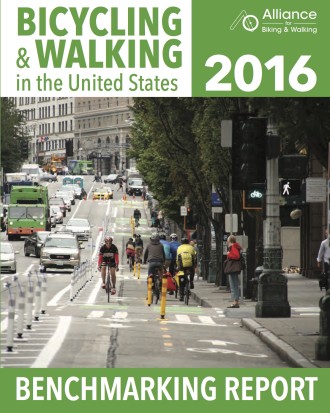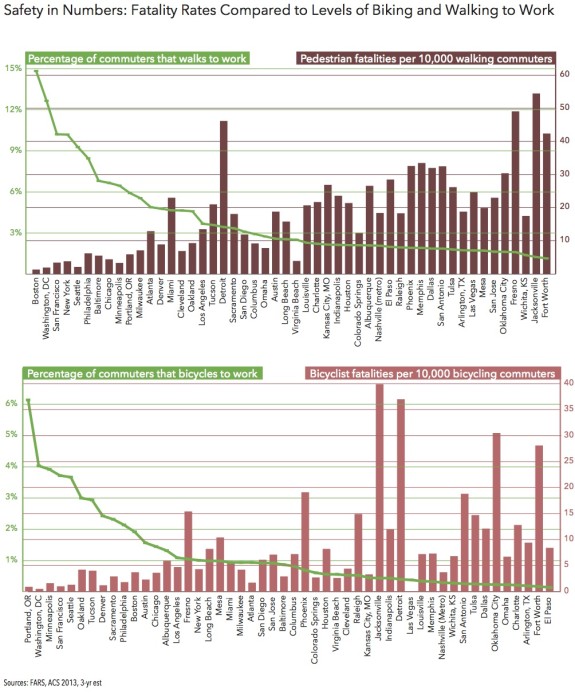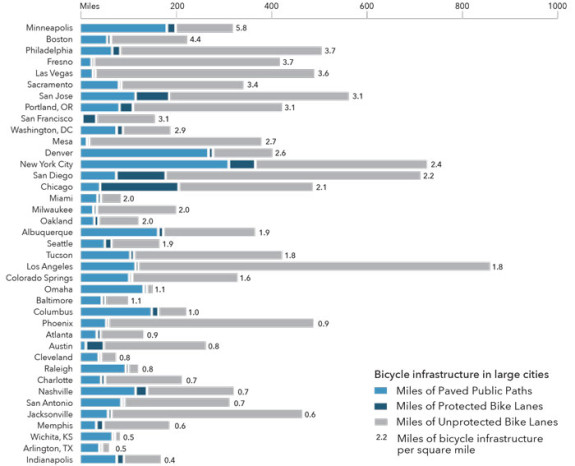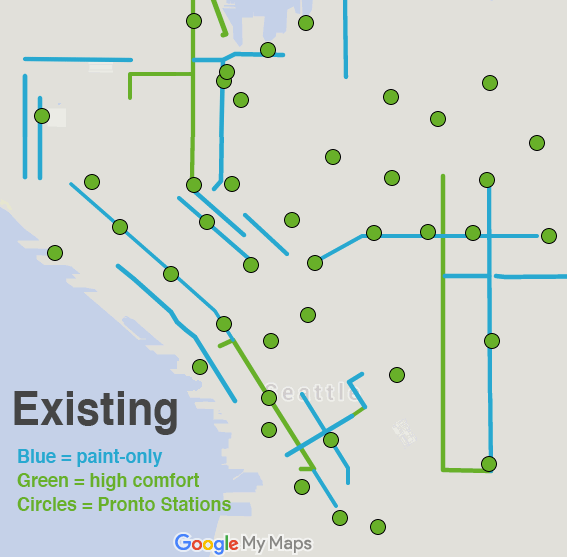Despite building few bicycle lanes, Seattle still stands out in a new national report as a walking and biking leader. In fact, we’re featured on the cover.

Both walking and biking to work has increased faster in Seattle than most other major U.S. cities, the report found. Across the country, as the number of people walking and biking increases, the fatality rate decreases. And Seattle is a leader in this trend:
 This data comes from the Alliance for Biking and Walking’s 2016 Benchmarking Report, which was released Wednesday (the report comes out every other year). It’s packed with data comparing major cities by a number of different measures. Seattle appears most consistently comparable to San Francisco and Washington DC in terms of biking and walking rates and safety.
This data comes from the Alliance for Biking and Walking’s 2016 Benchmarking Report, which was released Wednesday (the report comes out every other year). It’s packed with data comparing major cities by a number of different measures. Seattle appears most consistently comparable to San Francisco and Washington DC in terms of biking and walking rates and safety.

 But this high safety rating comes despite Seattle’s relatively low investment in bike lanes and paths. DC has 52 percent more miles of bike lanes per square mile than Seattle. San Francisco has 63 percent more. In fact, Seattle falls somewhere in the middle-to-low end of the list compared to major U.S. cities:
But this high safety rating comes despite Seattle’s relatively low investment in bike lanes and paths. DC has 52 percent more miles of bike lanes per square mile than Seattle. San Francisco has 63 percent more. In fact, Seattle falls somewhere in the middle-to-low end of the list compared to major U.S. cities:
 But with all the talking Seattle does about bike lanes, how could we fall so low on this list? Well, because we talk and talk, but rarely actually build. If this were a list of miles of bike lanes included in planning documents, Seattle would leave everyone else in the dust. But actually building bike lanes is the only thing that counts.
But with all the talking Seattle does about bike lanes, how could we fall so low on this list? Well, because we talk and talk, but rarely actually build. If this were a list of miles of bike lanes included in planning documents, Seattle would leave everyone else in the dust. But actually building bike lanes is the only thing that counts.
Now, just imagine what Seattle could accomplish by following through and getting our planned bike network — especially downtown — on the ground and fully connected. We have the plans, funding and political support. Now we just need action.
Seattle has a big head start on biking safety due to a culture of year-round biking that have developed and grown over decades. But we need safe and comfortable bike connections to become a true leader nationally and to achieve our goals of more and safer biking. We know it works when we build it, so let’s keep going.
As a reminder, here’s what Seattle could build within a year or two if leaders give existing and funded plans the go-ahead:









Comments
12 responses to “National report: Seattle is among the safest for biking and walking despite lacking infrastructure”
Note that their infrastructure categorization gives short shrift to some of the most significant bicycle and pedestrian infrastructure improvements in cities like Seattle.
Streets with narrow lanes, low speed limits, traffic calming, etc. *are* bicycle infrastructure, even if they’re not segregated bicycle infrastructure. The Alliance numbers assume that Neighborhood Greenways are no different from trying to control a lane on Rainier Avenue. We know that’s not true.
http://www.seattlebikeblog.com/2014/07/23/do-neighborhood-greenways-increase-cycling-oh-yes/
If I’m Frenso looking at this study, I’m wondering why Seattle is kicking my butt on bike commuting and fatalities, when my bike infrastructure density is at 3.7 miles per square mile. which is almost double Seattle’s density number (1.9). Should Fresno go out and build more bike infrastructure, or should it take a second and ask if maybe there is something else that Seattle is doing right for bikes that it could learn from?
Maybe Seattle should look at its success, notwithstanding its low bike infrastructure density number, and ask whether infrastructure density is really the key to promoting bike commuting and safety. In other words, I think it’s worth noting that this study seems to contradict the hypothesis bike infrastructure density is even correlated with good numbers on these metrics, let alone the cause of them. And then it’s worth asking what other factors may be in play.
As a native, I find that Detroit number of fatalities scary.
Seattle has a low motor vehicle mortality rate (3.0), even for a large city (which typically have lower rates than rural areas). Detroit has a high motor vehicle mortality rate (13).
Be careful discussing bicycle safety without motor vehicle crash rates.
Source: https://bchi.bigcitieshealth.org/indicator_category/Injury%20and%20Violence
There is another way of looking at the numbers that might focus attention somewhere other than the catechisms of Seattle Smug, which is a good deal more serious problem than the famous Seattle Process.
In the three years 2009 – 2011, Seattle saw 19 roadway pedestrian fatalities and 123 serious injury collisions. In the next (most recent) three years for which data is available, 2012 – 2014, those numbers climbed to 22 pedestrian fatalities and 145 serious injury collisions. In 2014, over a third of the pedestrian carnage fell on the 24-and-under and the 65-and-older age groups.
During the same 2009 – 2011 period, Seattle had 7 bicycle fatalities and 149 serious injury collisions. These numbers fell to 4 bicycle fatalities and 103 serious injury collisions in the three most recent years.
Even with the improving rates for cyclists, all these numbers are unacceptable and the wrong directions in the pedestrian rates are a very disturbing trend indeed.
In the spending projections taken to voters asked to approve the Move Seattle levy (which they did), SDOT forecast three years of spending from levy proceeds on pedestrian safety improvements of about $1.5 million per year, totaling $4.6 million over three years.
No one seems to have mentioned the point, but the $5 million Pronto expansion money could be redirected from a subsidy program for the few, the male and the able-aged. Instead it could be put into pedestrian safety improvements that would double the level of spending forecast for Move Seattle in the next three years and benefit every Seattle resident who walks along or across a street. Indeed, maybe that way some real progress might be made toward the over-arching SDOT goal of Vision Zero to which not even Pronto enthusiasts have claimed Pronto advances.
Could some councilor (or even SDOT) please put forward that choice? Or, alternatively, someone might do back of the envelope math and point out that $4 – $5 million finding its way back into alternative spending opportunities might translate itself into something like 35,000 to transit service hours. It shouldn’t be too challenging to figure out how to put more transit service hours in places where both equity and ordinary people’s transportation spending priorities for better transit would overlap. Pedestrian safety, transit, or Pronto: let’s talk seriously and a little more candidly about equity and priorities.
> Pedestrian safety, transit, or Pronto
When did it become an either-or? Each of the three pieces here serves a need that is not adequately served by the others.
It comes down to choices — either, or — when you have $5 million. As the old saying goes, you can only spend a dollar once. Just be honest enough to understand that once you’ve spent the money, you’ve answered the question. What’s the answer you choose? And why?
How about we stop spending billions on Bertha, and we give ped, transit and bike safety 3 times the money they need.
I put a pronto station on every corner from Bellingham to Battle Ground.
I don’t understand … how can Portland and Washington, D.C. and San Francisco have such low fatality rates when they have a lawless, free-for-all system of reckless safety abandonment, i.e. no mandatory all-ages helmet law!?!?!?!?!?!?!?
Oklahoma City DOES have a mandatory all-ages helmet law, but they have one of the country’s highest fatality rates for cyclists.
WAIT! HOW DOES THIS MAKE SENSE!?!?!?!?!??!?!?!?!??!
What the study fails to note is that Seattle has by far the highest density of sharrows of any city in the World. These constantly remind motorists of the need to be courteous to cyclists and cost very little.
As William and Jort Sandwich point out we’re not doing nothing here, but if all data are theory-laden then a study on infrastructure is only going to make sense from an infrastructure perspective.
We also have a culture, (believe it or not, and for many of you, clearly not…) of courtesy and accommodation on the roadway. People, particularly transplants, like to complain about how bad drivers are here, they tend to miss how good drivers are here. Great drivers? Probably not, and increasingly less so, but far better than average, from a cycling standpoint.
[…] to this blog post, Seattle is one of the safest places to commute to work by walking or biking! Despite that, it is […]